 April 2021
People from a planet without flowers would think we must be mad with joy the whole time to have such things about us.
~ Iris Murdoch
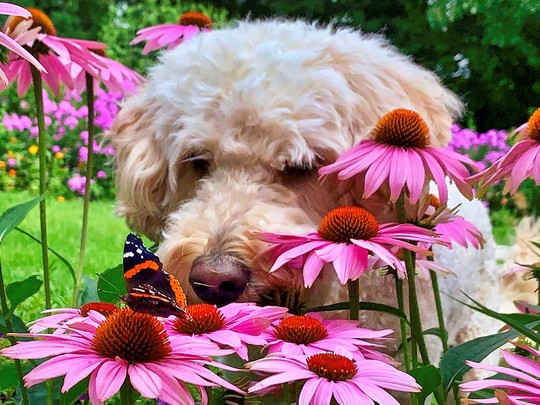 PHOTO CREDIT: Anmol Shrestha
May is Flower Moon month or Waabignwani giizis in Ojibwe (Anishinaabe). But we couldn't wait to deliver some colorful wildflowers to your inbox (compliments of some talented local photographers) and invite you to start planning your native landscaping and future visits to Minnesota State Parks and Trails.
With the warm temperatures and showers of spring, wildflowers start popping and adding color to the landscape. Many species start blooming in April and others as late as September.
Pick up a wildflower guide (but never the flower) to help you spot the great variety of species all around Minnesota.

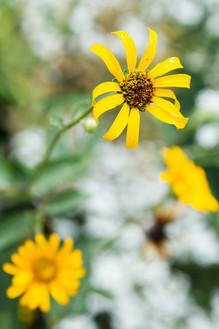
Native plant communities are native plant species that occur together and interact with each other and with their environment in ways not greatly altered by modern human activity or by introduced organisms. They form recognizable units, such as oak savannas, pine forests or marshes.
Specific plant species thrive in different environmental conditions and are consistent: Wherever conditions are similar, the species that occur there will also be similar.
Most native plants have been in the same area for centuries or longer and natural spread can continue to occur.
|
Woodland Sunflower. PHOTO CREDIT: Rodel Querubin
Improved Quality of Life
Native plant communities buffer waterways, store carbon, moderate temperature and help control erosion. In Minnesota, native plant communities provide habitat for several thousand plant and animal species.
For thousands of years, human lives in Minnesota have been closely connected with the resources available from plant communities — food, shelter, clothing, fuel and medicine. Prairie farms, fur trade, logging and recreation are examples of how plant communities have shaped human communities in our state.
Minnesota Wildflowers is a comprehensive online field guide to the flora of Minnesota, and the resource we used for this newsletter issue.
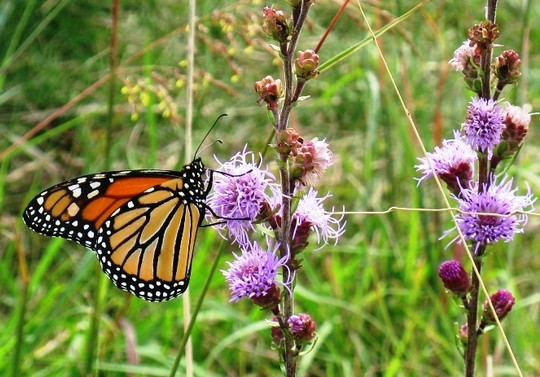 Monarch on a blazing star flower.
Pollinators help us to enjoy well-balanced diets and healthy ecosystems. They provide fruits, vegetables and nuts for humans and wildlife. At the same time, they depend on certain native plants to complete their life cycles.
Wild bee surveys in prairie-grassland habitats, Minnesota Conservation Volunteer article and video.

Native tallgrass prairie is the most endangered ecosystem in North America
Native prairie plants improve water quality, anchor soil, provide wildlife habitat and sequester carbon. Prairie plants have evolved to withstand harsh climate conditions on the Great Plains. They have deep roots (up to 14 feet, or four meters) that can remain alive and regenerate shoots after fire, drought and even grazing.
Pasqueflower
Blooms in April, shortly after snowmelt.
 PHOTO CREDIT: Jenny Wiersma
Flower is tulip-shaped, with five to eight lavender petal-like sepals and yellow centers. Used medicinally by Indigenous people.
Every April on Glendalough State Park’s Prairie Hill, hundreds of pasqueflowers herald the coming of spring in a display unmatched anywhere in the state. This small piece of native prairie inspired the restoration of hundreds of acres of old agricultural fields into prairie.
This song, translated from the Dakota language, celebrates the "twin flower," as the pasqueflower is known in Dakota:
I wish to encourage the children
Of other flower nations now appearing
All over the face of the earth;
So while they awaken from sleeping
And come up from the heart of the earth
I am standing here old and grey-headed.
Prairie Smoke
Blooms April to June.
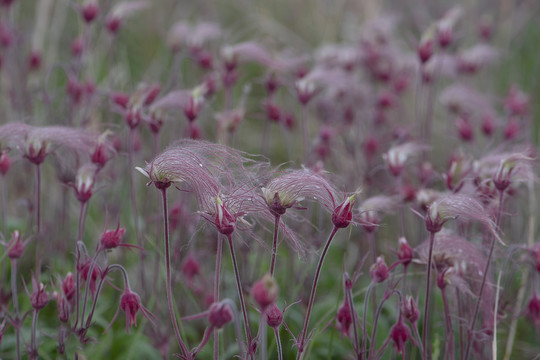 PHOTO CREDIT: Kelly Povo
Three flowers on long stalks at the top of a hairy but otherwise naked stem. Generally red, it nods down and remains bud-like when young but becomes erect and opens up after pollination.
Purple Coneflower
Blooms in July.
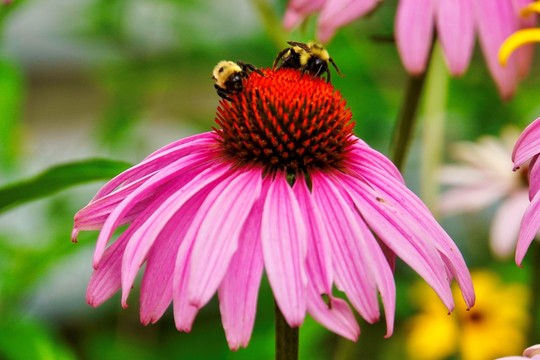 PHOTO CREDIT: Anmol Shrestha
Single, showy flower head with purplish, drooping ray flowers and brown, dome-shaped disk. Used for medicinal purposes by Indigenous peoples of the Great Plains and Canadian prairies.
Download the guide of Minnesota's prairie wildflowers.
See prairie wildflowers at...
Camden State Park, Central Lakes State Trail, Glendalough State Park and Shooting Star State Trail.
TOP

Deciduous trees lose their leaves in fall, creating rich forest soils where many different flowers and plants thrive. Ephemeral flowers shoot up while trees are still bare and wither in their shade once leaves grow.
Dutchman’s Breeches
Blooms April to May.
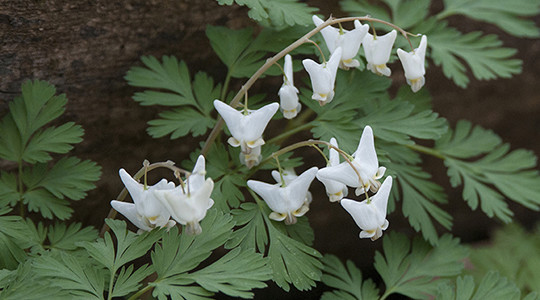 PHOTO CREDIT: Kelly Povo
Three to 14 white, occasionally pink, stalked flowers hanging down in a raceme at the end of a naked stem that rises above the leaves. Individual flowers have two opposing spurs that give the flower the shape of an arrowhead or breeches (short pants).
Dwarf Trout Lily
Blooms April to May. Endangered.
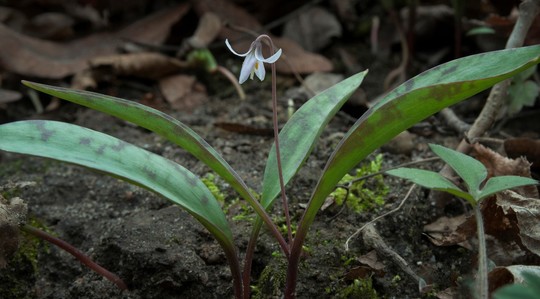 PHOTO CREDIT: Kelly Povo
The flower is no bigger than a dime. This endangered spring ephemeral is endemic to only three Minnesota counties and grows on slopes dominated by maple and basswood and adjoining floodplains dominated by elm and cottonwood. It can be spotted along the Cannon River State Water Trail (*).
(*) Cold water kills. We don't recommend paddling or swimming in the river. Warmer temps of spring don't equate warm, safe water.
Culver's Root
Blooms June to August.
 PHOTO CREDIT: Anmol Shrestha
Spike cluster up to 10 inches long (25.4 centimeters) densely packed with white tubular flowers that bloom from the bottom of the spike up.
Virginia Spring Beauty
Blooms April to June.
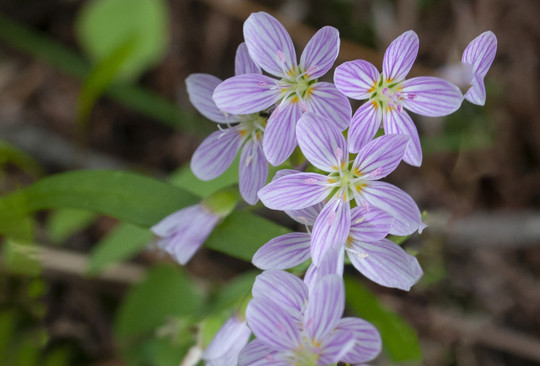 PHOTO CREDIT: Kelly Povo
Flowers grow in a raceme at the top of the plant and close up at night and on cloudy days. Closed flowers and buds nod down and become erect when the flower opens.
See deciduous forest flowers at...
Sakatah Lake State Park, Sakatah Singing Hills State Trail and Rice Lake State Park. At Carley State Park Virginia bluebells blanket the ground in late spring.
TOP
This biome is often considered to be cool and moist. Cold winters and cool summers caused by Arctic air masses are typical of the coniferous forest. Moisture levels are maintained by summer rains and heavy winter snows.
Pitcher Plant
Blooms May to August.
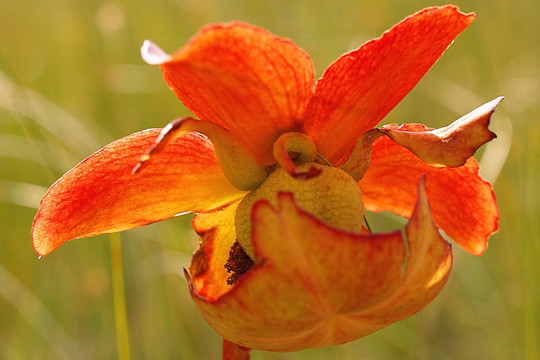 PHOTO CREDIT: Doug Easthouse, park manager at Big Bog State Park
Leaves form a pitcher-like tube with short, downward-pointing hairs at the top. At the bottom of the "pitcher," there's a pool with rainwater and insect-dissolving chemicals. Grows in bogs, where the soil is not very rich in nutrients that plants need to thrive. Instead, this and other carnivorous plants obtain their nutrients from insects.
Showy Lady's Slipper: Minnesota's State Flower
Blooms June to July.
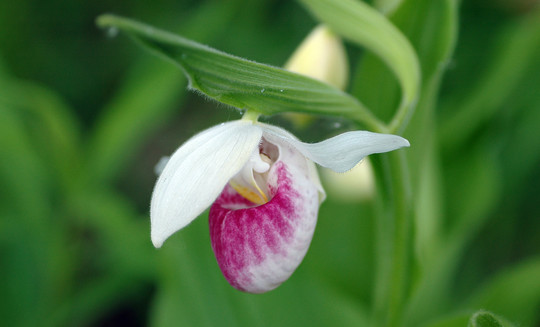 It can take between four and 16 years to produce its first flower, can live a hundred years and can grow up to four feet tall. Travel the Lady Slipper Scenic Byway to observe more than 10,000 showy lady's slippers.
Sundew
Blooms June to August.
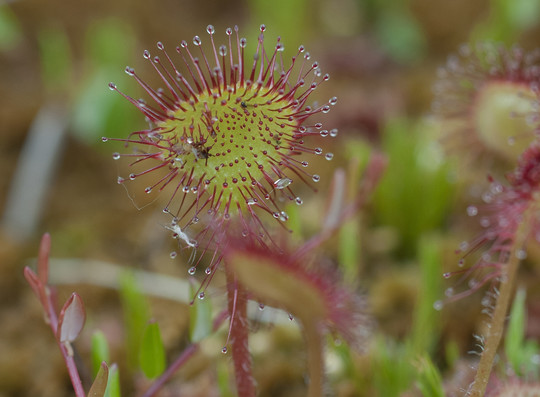 PHOTO CREDIT: Kelly Povo
Numerous species of these glittering, jewel-like plants dot the floor of the savanna. They lure insects using stalked glands covered with droplets of very sticky secretions at the ends of their leaves. Their name comes from these glistening secretions that cover their surfaces, resembling morning dew.
Wild Lupine
Blooms June to July.
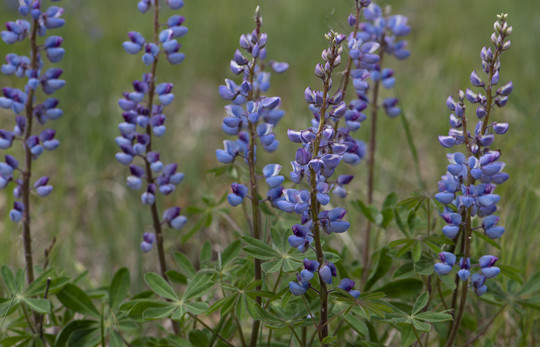 PHOTO CREDIT: Kelly Povo
The only host plant for the Karner blue butterfly caterpillar. Habitat loss has led to the decline in plants and put the Karner blue on the endangered species list. At Wild River State Park efforts have been made to increase the lupine population, as Karner blues have been seen just across the St. Croix River in Wisconsin.
Flowers grow in a spike-like cluster on a short stalk, and may be blue, two-tone blue and purple, or blue and white. This wild lupine is not to be confused with the slightly larger lupine, an invasive species introduced by gardeners and commonly seen on roadsides along the North Shore.
See coniferous forest flowers at...
Lake Bemidji State Park, the North Shore, Willard Munger State Trail, and Big Bog State Recreation Area.
TOP
Plants and animals are well adjusted to harsh winds, extreme temperatures and dry conditions characteristic of this biome, where prairie and forest landscapes meet. Evapotranspiration is greater than precipitation across this biome in Minnesota. More water evaporates from the ground and transpires from plants than falls from annual rain and snow!
Butterfly Milkweed
Blooms June to September.
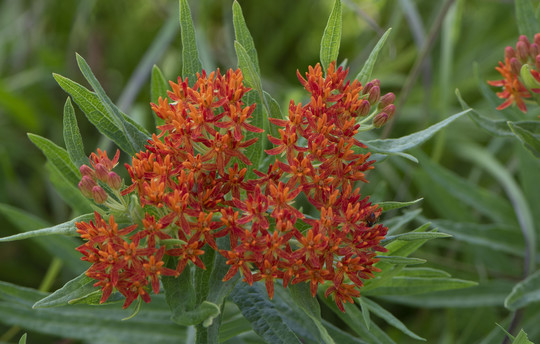 PHOTO CREDIT: Kelly Povo
Flat-topped clusters of up to 25 flowers. Flowers have a five-parted crown with a curved horn. Flower color is primarily orange but ranges from orange-yellow to red. Host plant for Monarch (and other) butterfly caterpillars.
Northern Plains Blazing Star
Blooms July to August.
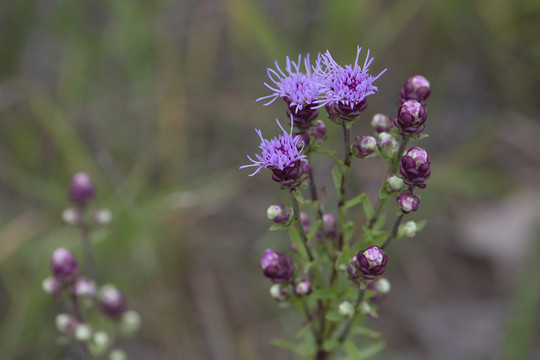 PHOTO CREDIT: Kelly Povo
This is one of five species of this perennial plant native to Minnesota. Dense spikes of showy, rose-purple flower heads (typically three to 10 flower heads per stem, with 30 to 100 flowers per head).
See tallgrass Aspen parkland flowers at...
Lake Bronson State Park and Old Mill State Park (Agassiz Self-Guided Trail.)
TOP

Kelly Povo
Povo has been a professional photographer for 30 years and has exhibited in galleries and art shows across the country. Her cards, gift books, and calendars have been sold internationally. Listen to Kelly Povo's dispatch (on wildflowers, of course) on Minnesota Public Radio or follow her chase on FlowerChasers.com.
Anmol Shrestha
Shrestha is originally from Kathmandu, Nepal and has lived in the United States since 1980. "Photography is a very recent hobby which has allowed me to see beauty in everything around us," says Shrestha. See more of Anmol Shretha's work on Instagram @jhetta.
Rodel Querubin
Querubin is a Filipinx-American commercial and family photographer, rock and ice climber, snowboarder and cross-country skier. As an all-around outdoor enthusiast, Querubin likes to help increase access and outdoor enjoyment for Black, Indigenous and people of color (BIPOC) communities.
Jenny Wiersma
Wiersma is a visual artist who spends summer weekends in the Fergus Falls area watching birds and photographing nature. They’ve been a Minnesota State Parks and Trails volunteer for 20 years. Wiersma also enjoys storm chasing and amateur paleontology.
TOP

Earth Day is observed on April 22. The theme for 2021 is Restore Our Earth™. One way is to plant native species: A diversity of native plants will bloom and provide pollen and nectar in spring, summer and fall for native birds, pollinators and other wildlife. They will foster better wildlife habitat, protect and build soil and filter polluted runoff through the soil. Native plants seldom need watering, mulching or protection from frost once established.
Take a virtual tour of Minnesota Scientific and Natural Areas to see the different native plant communities around our state.
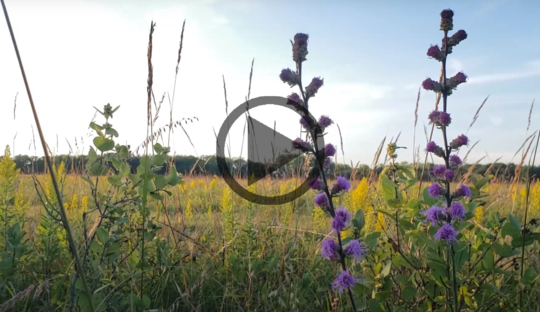

What season is it? It's get outside season. Conditions are conducive to wildflowers blooming, and for ticks to be out.
So it's time to have the tick talk.
Next time you spend time outdoors...
✴ PREVENT
Wear light colored clothing, ideally pre-treated with permethrin. Tuck pants in boots or socks, or use gaiters. Spray exposed skin with insect repellent (DEET is ideal.)
✴ CHECK
Do full-body check (for you, pets, kids) after being outdoors to look for ticks. Bag clothes before going in vehicle and put in dryer for at least 15 minutes (heat kills ticks.)
✴ REMOVE TICK... (if you find one)
... as soon as possible but slowly and carefully so you don't leave any bits behind! Use tweezers and do not squeeze tick.
✴ CHECK AGAIN
Check for symptoms related to tickborne diseases, even if you don't find the classic bullseye mark from a tick bite.
Ticks are most active in spring, but remain tick-aware through fall. Any time temperatures are over 40 degrees Fahrenheit (four degrees Celsius) consider tick protection.
Preventing tickborne disease, from the Minnesota Department of Health.
 The faces and stories of our visitors and staff.
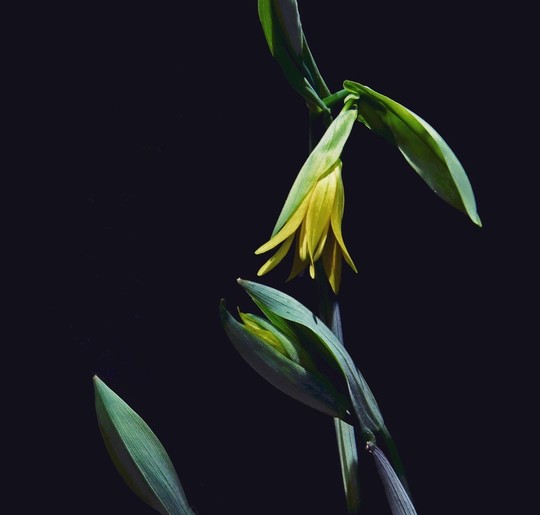 Large-flowered Bellwort: Hanging yellow flower one to two inches long with six droopy, narrow petals that are somewhat twisted; one to a few flowers per stem. Grows in most of Minnesota between April and June. PHOTO: Sarah Lilja

I am a photographer with a passion for natural places. I want my photographs to inspire and expand people’s experience of the natural world, so that they, too, will get outside and explore the many wonders, big and small, found in Minnesota.
My husband and I like to kayak and take the motorboat on the St. Croix River, one of our favorite destinations. We also love Interstate State Park and exploring the many SNAs around the state.
|
|